Heavy white frosts have also made their appearance here, coating rooftops, grass and cars in a blanket of glittering white crystals. In one of our recent journeys, John had to scrape the frost of all of the car windows before we could drive it.
This was the morning we had picked to visit the Ouse Washes, and the reserve there which is run by the RSPB (Royal Society for the Protection of Birds).
Our journey there was quite lovely, as we drove through fields of white frost. It was so thick in some areas, it gave the appearance of snow.
Our journey there was quite lovely, as we drove through fields of white frost. It was so thick in some areas, it gave the appearance of snow.
This snowlike frost was also in abundance at the reserve; as we drove in, the bank alongside of us was completely white. Here is the picnic area near the car park when we arrived around 11 am. Needless to say, a picnic was not on our agenda that day.
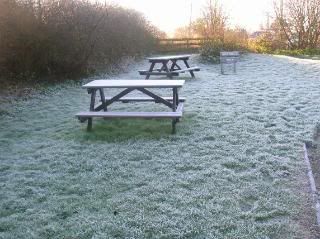
Though thinking regretfully of the heated hide of Welney, we made our way up the track to go to the nearest hide. This reserve was not too far from that of Welney, and we hoped to see some more wildfowl in their natural habitat. Not only were the banks still in shadow white with frost, but the puddles of water on the track were frozen solid. Elizabeth had fun sliding and stomping on them, as frozen puddles were a phenomena that had not featured in her childhood! Here she is, rugged up and pausing momentarily from the business of examining them.
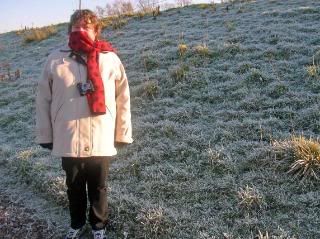
The Ouse Washes is an example of lowland wet grassland habitat, and according to the RSPB, is home to thousands of wildfowl every winter, including swans, ducks, snipe and godwits.
(Yes, these photos come from the same day...the land that was sheltered from the sun was still frosty, but the land where the sun had already reached was beautifully coloured in the bright daylight.)
Another non water bird that this reserve is also famous for is the Tree Sparrow [photo below, from Wikipedia]. Once abundant in England, its numbers have declined rapidly in the last few decades. There was a large flock of them hanging around the car park and the bird feeder here, and they had no lack of birdwatching admirers armed with large cameras.
Up in the hide, the air was very cool but at least we were out of the breeze. The marshland in front of us looked empty at first, but as our eyes adjusted to the scene we realised it was alive with small waterfowl.
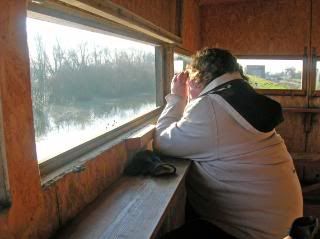
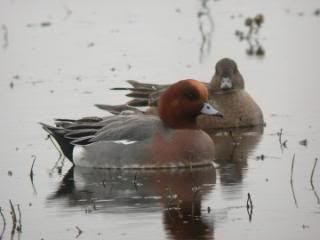
Wigeon were everywhere
[photo above from
http://www.birdlist.co.uk/scrapbook.htm
accessed 16/12/07];
as were the smaller teal ducks
[photo below from
http://www.birdlist.co.uk/scrapbook.htm
accessed 16/12/07].
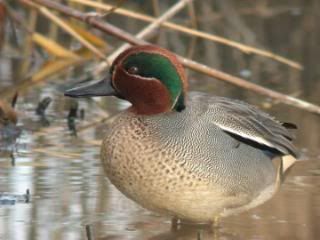
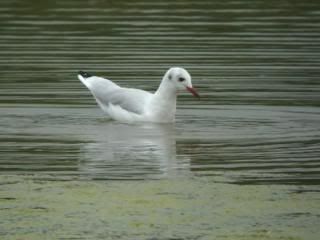
A lone black-headed seagull [photo above, from Wikipedia] apparently had taken patrol duty upon himself, and swam up and down in front of the hide, between it and the ducks. Lots of moorhen and coots were also feeding. To Elizabeth’s disappointment, no Bewick’s swans (or any swan, for that matter) could be seen from the hide.
After leaving the reserve, we made our way to Wisbech for lunch. Wisbech is another market town that can trace its history back to medieval times. Originally a very small port (it was only 4 miles from the sea), it grew larger and more prosperous when the Fens were drained in the mid 1600s. The resultant fertile farmland meant agricultural prosperity came to the town.
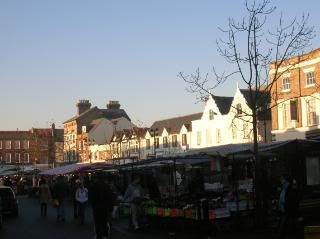
By the 18th century, Wisbech attracted the business of bankers, merchants and other tradesmen such as brewers. The wealthy owners of these enterprises built elegant houses along the banks of the River Nene. For more details on this, see our earlier entry on Peckover House at Wisbech.
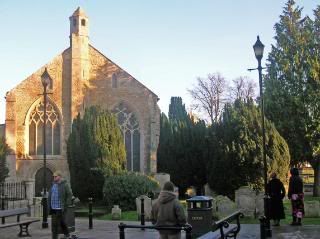
We stopped to admire the parish church which is distinguished by a very large tower over its entrance.
The parish website has this to say about it:
"The beautiful Parish Church is an early example of the Perpendicular period of architecture. The Nave, with its north and south aisles measures some eighty feet in length and fifty feet in width. The fifteenth century Porch protects the main entrance door, which is in the south aisle. The finely proportioned Chancel measures forty feet by twenty feet. At the west end of the church is the Tower, which has watched over the village for nearly 700 years."
(accessed from http://www.wisbechstmary.org.uk/page49.html on 16/12/2007).
The town still has a thriving marketplace, and there are monuments scattered around dedicated to those who worked to abolish the slave trade.

After lunch we decided to explore fen territory a bit more, and headed in the general direction of The Wash. This is a large bay between the coast of East Anglia and that of Lincolnshire.
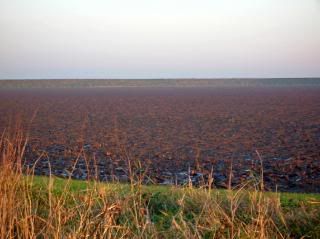
According to Wikipedia, The Wash
"has three roughly straight sides meeting at right angles, each about 25 kilometres (15 miles) in length. The eastern coast of The Wash is entirely within Norfolk, and extends from Hunstanton in the north to the mouth of the River Great Ouse at King's Lynn in the south. The opposing coast, which is roughly parallel to the east coast, runs from Gibraltar Point to the mouth of the River Welland, all within Lincolnshire. The southern coast runs roughly northwest-southeast, connects these two river mouths, and is punctuated by the mouth of a third river, the River Nene."
Inland from the Wash the land is flat, low-lying, and often marshy: these are the Fens of Lincolnshire, Cambridgeshire and Norfolk.
Owing to deposits of sediment, the coastline of The Wash has altered markedly within historical times; several towns once on the coast of The Wash (notably King's Lynn) are now some distance inland. Much of The Wash itself is very shallow, with several large sandbanks—such as Breast Sand, Bulldog Sand, Roger Sand, and Old South Sand—exposed at low tide, especially along its south coast. For this reason, navigation in The Wash can be hazardous for boats. A lightship marks the entrance to the Lynn Channel, the one safe channel from the North Sea to The Wash's south coast.
The most famous incident associated with The Wash is the loss of King John's royal treasure. According to contemporary reports, John travelled from Spalding in Lincolnshire to Bishop's Lynn, in Norfolk, was taken ill and decided to return. While he took the longer route by way of Wisbech, he sent his baggage train, including his crown jewels, along the causeway and ford across the mouth of the Wellstream. This route was usable only on the lower part of the tide. The horse-drawn wagons moved too slowly for the incoming tide, and many were lost.
There is also a suspicion that John left his jewels in Lynn as security for a loan and arranged their "loss". This looks likely to be apocryphal. However that may be, he passed the following night, that of 12 to 13 October 1216, at Swineshead Abbey, moved on to Newark-on-Trent and died of his illness on 19 October. (http://en.wikipedia.org/wiki/ accessed 16/12/07)
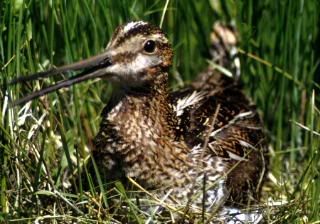
We drove through a number of small fen villages, and went as close to The Wash as possible. One highlight was that Elizabeth spotted a snipe [photo image above, from Wikipedia] leisurely foraging in a ditch. After waiting for an hour or so to see one in the hide with no luck, it was good luck to find this one without looking for it.
Evening was beginning to draw in (after all, it was 3.45pm!) and the mist or haze that is characteristic of the fens in winter began to appear.
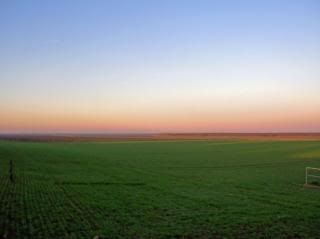
According to the website of the Shropshire family (farmers in the fen area), this mist has given rise to many ghost stories over the years.
One tale has it that ghostly figures can be seen stalking the Fens in the late evening. Are these just mist or fog? Or witches searching for the bodies of drowned Fenman? Or even the ghost of a large hound called 'Black Shuck'?
The answer is more prosaic…when the damp marshy ground warms up in daytime, if gives off a gas. In the evening when the air turns cooler, the gas is still emitted from the relatively warm ground, but the water vapour content can be seen, and this can often resemble a ghostly figure...
(accessed 16/1207 from http://www.shropshires.com/ourfamily/fens.asp)
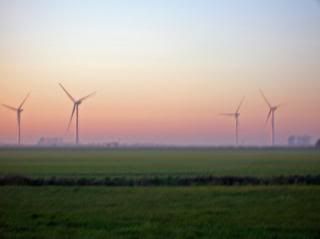
We will leave the last word on The Fens to an anonymous Fenland poet, obviously writing at a similar time of the year:
The sky's are red,
The lambkins are fed
The snow is beginning to fall
There is mud on the stones
A chill in the bones
And Slime on the old stable walls
The curtains are rosy
The firelight is cosy
The food smells are calling me there
The sofa is deep
The cat fast asleep
And 'Dang me!' she's taken my chair
We headed back to Cambridge, with the mist floating around us above a surreal landscape, and a silvery gibbous moon hanging above the darkened trees in a twilight sky. There is certainly something fascinating about fen territory, and look forward to our next visit there.
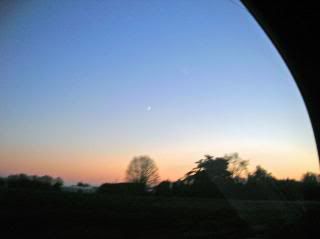

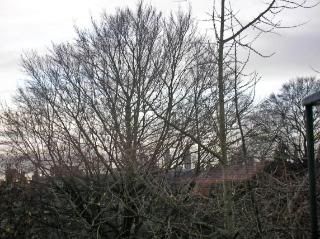
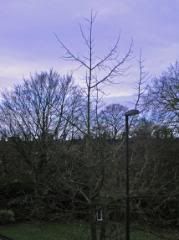

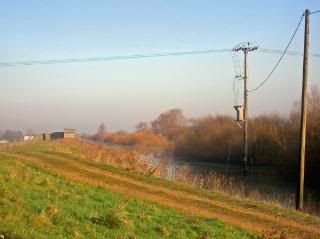
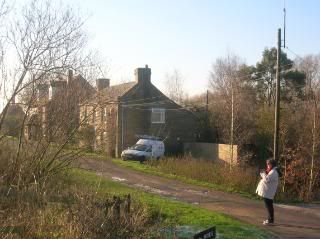
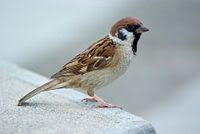
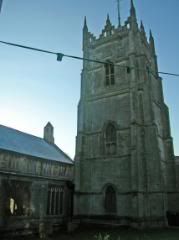
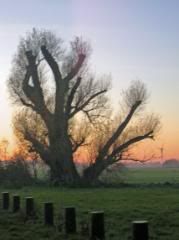
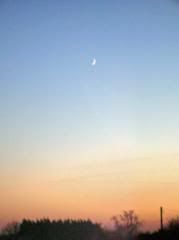

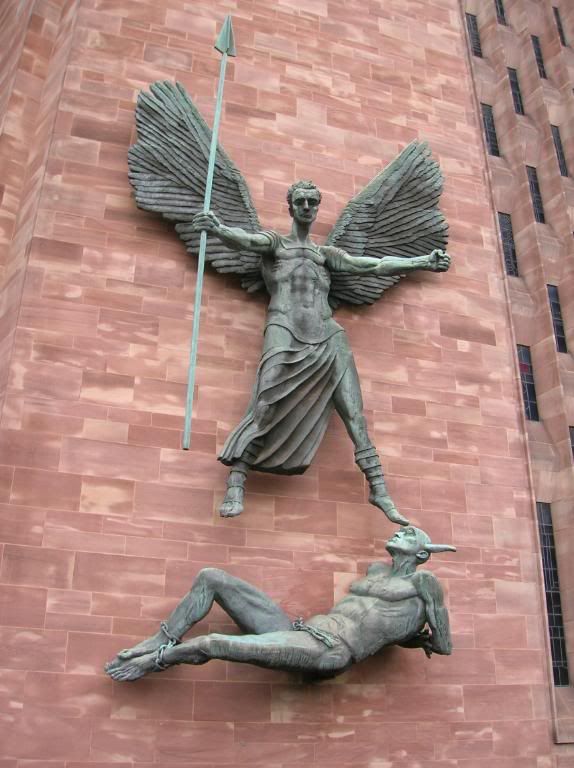

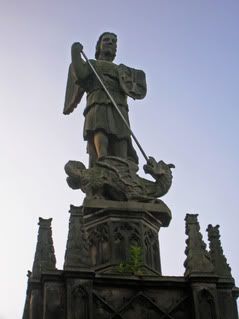
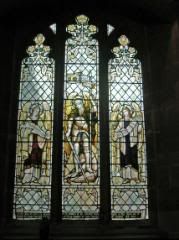
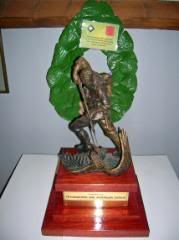


No comments:
Post a Comment